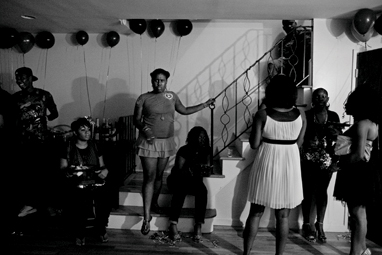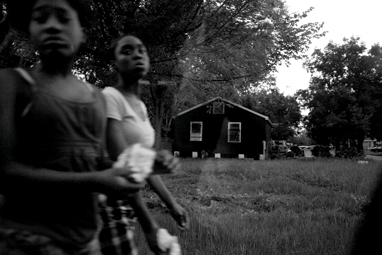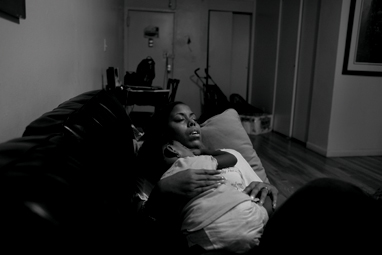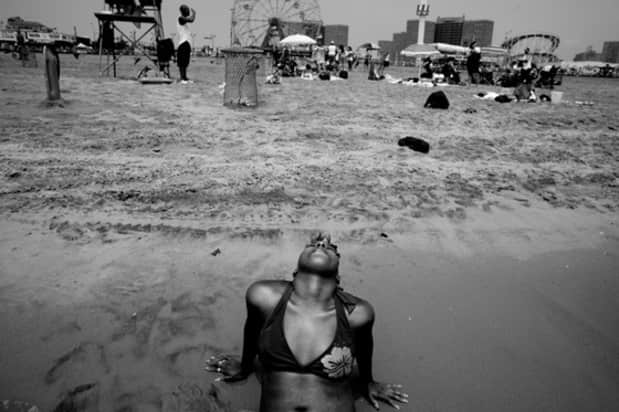In our current Photo Issue, we feature some of our frequent contributors' most personal work. Longtime FADER photographer Krisanne Johnson documented the lives of several young African-American women living with HIV and AIDS. We've collected many of the photos along with audio commentary by Johnson and one of her subjects, Lolisa Gibson, in this slideshow, and after the jump, you can read Matthew Schnipper's essay which ran with the photos in the magazine. Next Monday, we will post the next slideshow and feature: Gabriele Stabile's "Temporary Residence," focusing on transition motels many refugees must stay in when they first arrive in the United States.
When Marvelyn Brown talks, her upper lip rises up and to the side. The rest of her mouth has to catch up. Sitting outside in Madison Square Park, on her way to TJ Maxx to return clothes, she’s wearing a bright pink dress and eating yellow rice from Whole Foods with her mouth open. As she talks loudly about her HIV status and other things, a couple playing Scrabble continually looks over. She doesn’t notice.
“DC is one in twenty [people with HIV or AIDS], but America’s on its way to being one in twenty,” she says. “These rates are going higher and higher. They’re not coming down. Right now people wanna say, Oh it’s a black disease. Okay, well we’ll get the problem solved in black America, then it’s going to white America, Latinos. It just keeps on going.” But to the twenty-four-year-old Brown, statistics are irrelevant because she is HIV positive, and has been since she contracted the disease via unprotected sex at age nineteen. Her status is not something that can be lowered or eroded.

As tiny, sparkling Lolisa Gibson and I wait for burgers on the endless Shake Shack line in the late summer sun, she opens up quickly and tells me about how she was born HIV-positive (passed on from her mother, who did not know she was positive) but was not diagnosed until she began experiencing severe symptoms—after her disease had evolved into AIDS—when she was seventeen. Gibson works as an advocate for and mentor to younger children—though she herself is only twenty-one—and is about to travel to the UK on a two-month speaking engagement. She folds over her palm and shows me the tattoo on her wrist: a long braided chain that holds a red ribbon on the back of her hand. To some family and friends back in Delaware who don’t know she is positive, the tattoo is simply a symbol that she is very passionate about her work. For them, her positive status is not just an unlikelihood, it is an entirely alien possibility.
“When I was little I always wanted to work with people,” she says. “I used to play school with my cousins. Then I wanted to be a social worker and I wanted to be a child protective worker, so when this came it was like, Okay I’m going to work with kids that have HIV. This is important. I’m not going to go one day without giving somebody a fact.” Gibson is born to help, her soft, slow paced voice warming to the ear. She speaks not like an educator but like a concerned and loving friend. There is no pandering and she’s not trite or overbearing, just kindly blunt. “To me it’s fun because you’re young, you’re educating people, they listen and you can change somebody’s life. I wouldn’t rather do nothing else.”

Brown’s attitude towards education and change is more gruff. She has a sorrowful disdain for older HIV educators who cannot bridge the gap to teach young people. Before she contracted HIV she was worried about becoming pregnant, but never about becoming infected. While Brown was taping a segment on NPR, an advocate on the show mentioned that she had been to Tennessee speaking around the time Brown contracted the disease. “What makes you think me at eighteen was going to listen to you?” she said. “You’re talking about HIV, I’m worried about the prom. I’m trying to figure out what I’m going to wear, what I’m doing tonight. HIV is not in this conversation. That’s the reason why I didn’t know. Because I didn’t care to know.” Both Brown and Gibson strive to get other young people, their own peers, to pay attention. And though there is progress, neither has any delusions of success. AIDS is the number one cause of death for black women in the US ages twenty-five to forty-four. Two-thirds of HIV positive women in the US are black. These statistics say nothing of the social stigma related to the disease, which contributes to a lack of education and misconceptions about HIV and is a huge barrier to outreach and treatment. Brown herself moved from her native Tennessee to Washington, DC but left the city after a year, frustrated that though the city’s infection rates were so high, “There was no type of support from other people living with HIV,” she says. “No one wanted to talk about it. It was like this big secret, and the more people were secretive about it, the more I felt bad that I was out about it.”
Both women live in Brooklyn now, variously assisted with housing and insurance by New York’s HIV/AIDs Service Administration. They recognize the progress implicit in the existence of such an organization but bemoan the lack of public support in other cities, especially when compared to US’s international efforts to combat the disease. At the recent International AIDS Conference in Mexico, Brown says the international participants’ impression is that HIV and AIDS has all but been eradicated in the US. She told them, to their great surprise, that she struggles to pay for her medicine. They told her George Bush pays for theirs.

Both Brown and Gibson struggle with how to portray the disease publicly. In Krisanne Johnson’s photos of them and other HIV-positive women in Mississippi and New York City, they appear lithe, stark and youthful. Both women are essentially healthy and take only four pills a day (though one of those pills is described as absurdly enormous). Gibson describes her disease as being “undetectable,” which is, she says, “like when you have cancer and you’re in remission.” The collision of fatal disease with tiptop health creates a conundrum for advocates: how do you warn people of the risks, without portraying the HIV-positive as eternally sick? Though HIV and AIDS pervade everything they think and do, neither Brown nor Gibson deny their current wellness. They don’t want to be poster children for their disease, but neither woman has found a viable alternative to advocacy, and so the slog continues.
A few days after we meet is the release date for Brown’s new memoir, The Naked Truth: Young, Beautiful, and (HIV) Positive. She is scheduled to be on CBS’s Early Show to discuss it that morning, but is bumped with no notice. That morning a piece on a Happy Days reunion does run. Though she tapes a segment later that week, it currently has no air date. They tell her only that it may be rescheduled, but probably not until World AIDS Day.
